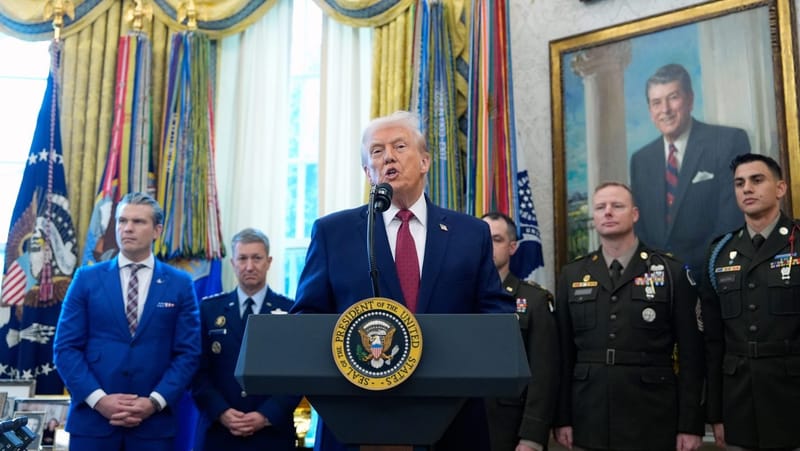Federal Reserve Slashes Interest Rates for First Time in Nine Months Amid Labor Market Fears
Central Bank Lowers Benchmark Rate by Quarter Point to 4%-4.25%, Signals More Cuts Ahead as Job Growth Slows and Tariffs Stoke Inflation Worries September 17, 2025 Washington, D.C. – In a long-anticipated move, the Federal Reserve announced on Wednesday its first interest rate cut of the year, trimming
Central Bank Lowers Benchmark Rate by Quarter Point to 4%-4.25%, Signals More Cuts Ahead as Job Growth Slows and Tariffs Stoke Inflation Worries
September 17, 2025
Washington, D.C. – In a long-anticipated move, the Federal Reserve announced on Wednesday its first interest rate cut of the year, trimming its benchmark federal funds rate by 25 basis points to a range of 4% to 4.25%. The decision, which ends a nine-month pause on rate adjustments, comes as signs of a weakening labor market eclipse persistent inflationary pressures, including those fueled by President Donald Trump's tariff policies.
Federal Reserve Chair Jerome Powell, in a post-meeting press conference, emphasized that the cut was designed to "cushion the sagging job market" while maintaining vigilance on inflation, which stood at 2.9% year-over-year in August—well above the central bank's 2% target. "Downside risks to employment are rising, and we must act to support our dual mandate of maximum employment and price stability," Powell stated, acknowledging the delicate balance policymakers face amid a politically charged economic landscape.
🚨BREAKING🚨
— Ash Crypto (@Ashcryptoreal) September 17, 2025
FED CUT RATES BY 25 BPS.
AS EXPECTED, GIGA BULLISH 🔥 pic.twitter.com/9X8nPgsC73
The rate reduction was nearly unanimous among the Federal Open Market Committee (FOMC), with 105 of 107 economists surveyed in a recent Reuters poll predicting the quarter-point trim. However, fissures emerged within the committee itself. Newly appointed Fed Governor Stephen Miran, a Trump nominee, dissented in favor of a more aggressive half-point (50 basis point) cut, arguing for bolder action to avert a potential recession. Miran's vote highlights growing internal debates over the pace of easing, especially as Trump has ramped up public pressure on the Fed, posting on social media earlier this week that the committee "MUST CUT INTEREST RATES, NOW, AND BIGGER THAN [Powell] HAD IN MIND."
### Labor Woes Trump Inflation Fears
The Fed's pivot follows a string of disappointing labor reports, including slower-than-expected hiring and rising unemployment signals. August job growth fell short of forecasts, prompting markets to fully price in the September cut and now anticipate up to three reductions by year-end—a shift from just two expected weeks ago. Fed funds futures markets reflect this optimism, with traders betting on a total of 75 basis points in cuts through December.
BREAKING: The Federal Reserve cut its benchmark interest rate a quarter of a percentage point, opting for its first interest rate cut this year in an effort to revive the flagging labor market. https://t.co/RVuAiJvBiM pic.twitter.com/drNwtIkx1X
— ABC News (@ABC) September 17, 2025
Yet, the decision wasn't without controversy. Inflation has ticked higher due to double-digit tariffs on imports like coffee, clothing, and small appliances, raising costs for American consumers and businesses. Critics, including some FOMC members, worry that easing too soon could reignite price pressures. "The possibility of a 50 bp cut may be off the table unless we see recessionary signals," noted Raymond James Chief Economist Eugenio Aleman in a recent analysis. Still, a majority of economists—64 of 107 in the Reuters survey—expect at least 50 basis points in total cuts by the end of 2025, with 37% forecasting a fuller 75 basis points.
Broader Economic Ripples and Political Shadows
For everyday Americans, the cut offers modest relief on high-interest debt. Credit card rates, auto loans, and adjustable-rate mortgages could dip slightly in the coming months, though experts caution that one small reduction "won't make much difference when bills come due," as LendingTree Chief Credit Analyst Matt Schulz put it. On the flip side, savers may see yields on high-interest accounts erode further.
The political undertones are unmistakable. Trump's administration has intensified its campaign against the Fed, including a failed attempt to oust Governor Lisa Cook via social media last month—a move temporarily halted by federal courts. Such interventions underscore tensions between the White House and the independent central bank, with some analysts warning of potential policy errors if political pressures dictate monetary decisions.
Looking ahead, the Fed's updated quarterly projections, released alongside the announcement, will provide clues on future moves. While baseline forecasts call for gradual easing, the wide range of opinions—from one tactical cut to a more protracted cycle—suggests uncertainty lingers. New York Fed President John C. Williams recently reiterated that data, not politics, will drive the path forward: "If progress on our dual-mandate goals continues, it will become appropriate to move interest rates toward a more neutral stance over time."
As markets digest the news—U.S. stocks surged in after-hours trading, while bond yields dipped—the Fed's action marks a pivotal recalibration in an economy teetering between slowdown and stubborn price growth. Whether this first cut stabilizes the labor market or invites renewed inflationary woes remains the trillion-dollar question.




